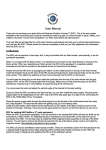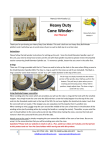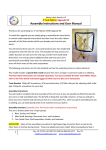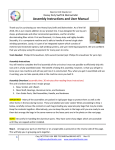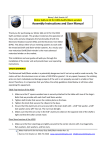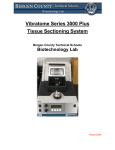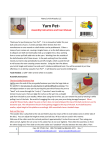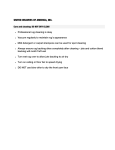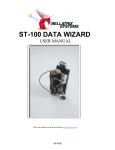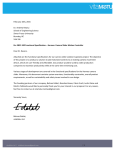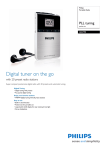Download Assembly Instructions and User Manual
Transcript
Nancy’s Knit Knacks LLC Heavy Duty Swift & Skein-winder Assembly Instructions and User Manual Thank you for purchasing our new Heavy Duty Swift and Skeinwinder. It was originally introduced to the market in the Fall of 2010 and we have made numerous additions to it since that time. It was designed for use by yarn shops, professionals and other commercial operations, and for all other discriminating fiber artists. First and foremost, it is heavy duty and highly durable. Secondly, it is a competent machine and is able to handle both single and multi- skein winding operations. Lastly, it is part of an integrated system which consists of metered and motorized options, ball winding systems, and yarn metering equipment. We are confident that you will enjoy using this equipment for many years to come. Tools Needed: Philips #2 Screwdriver, 9/16 wrench/socket, 5/32 Allen Wrench for adjusting shaft collar Assembly Instructions You will need to complete the final assembly of the unit since it was not possible to efficiently ship this size unit in a fully assembled state. The benefit of doing this assembly, however, is that you will get to know your new machine and will see just how it is constructed. Plus, when you get it assembled and see it working, you can take special pride in the machine since you built it. Assembly Overview (assembly time: 30 minutes after reading these instructions) The unit is broken down into 3 major groups 1. Base, Socket, and I-Beam 2. Main Shaft, Bearings, Aluminum Arms, and hardware 3. Yarn Guide Posts, Sled Assemblies, Handle, and hardware IMPORTANT - Many of the assemblies are packed in rigid paper bags to protect them as well as the other items in the box during transit. When proceeding to Step 1 below, carefully remove the contents in each bag including any separate poly bags that may be inside. Keep the contents together. Alternatively, you can keep the parts in the bags until you are ready to use them but arrange the bags in the same manner as the loose parts are in the photo on the next page. NOTE! Be careful in handling the aluminum parts. They have some sharp edges which are accessible until they are capped and/or installed. 1 Cary, NC 27518 USA 800-731-5648 Fax 866-445-4371 Rev. 20.7 [email protected] www.nancysknitknacks.com Step 1 Arrange your parts on the floor or on a large table as pictured on the reverse side of this page. This will help you in grouping parts together. The Yarn guide posts are all now Flexi-Skeiner type. * these items are only included with Skein-winders Some parts may not be pictured above such as the Rotation Counter and black metal mounting bracket and tilt assy., a white plastic washer for the I Beam knob, lock washers for the Stop screws, a 5/32” Allen Wrench and possibly other parts. Plus, this picture shows our old style wooden Yarn Guides as opposed to our new metal Flexi-Skeiner guides, The stop screws that are installed on the Arms have been left off to allow you to install the Yarn Guide Sleds and Handle assy. You will need to install these (one on each end of each arm) after installing the sleds. Put a lock washer under each screw’s head. 2 Cary, NC 27518 USA 800-731-5648 Fax 866-445-4371 Rev. 20.7 [email protected] www.nancysknitknacks.com PLEASE NOTE! – Do not move or slide the SLEDS (the 4 yarn guides that hold the yarn) by grasping the Yarn Guide rod and plastic disc. ONLY slide the Sled by holding the Black Knob that control the brake. Loosen the knob first, pull gently up on the knob and then slide the entire assembly forward or back. Then retighten the knob. If you hold onto the yarn guide rod and disc to slide the yarn guide it may bend and will void your warranty Step 2 Arrange the Base and Socket Assy. on your table top. You have a choice of mounting the 2 clamp bolts from the front edge of the table or you can mount one on the front and one on an adjacent side. If you do it this way, the bolts should be inserted into the slots so that they are the farthest from each other in order to create the best leverage. You can also install the base in any of the other three directions by simply rotating the entire base before installing the clamp bolts. Key Feature: You can adjust the angle of the Socket and I-beam by loosening the 2 knobs and turning the Socket assy. left or right up to 45 degrees. You would do this to better aim the Swift toward your ball winder or other tool/yarn supply. Our unit can be aimed at any location within 360 degrees of the base by means of changing the base’s positioning on the table and through rotating the socket. Always tighten the 2 knobs securely before using the Swift! Step 3 Insert the I-Beam into the Socket Assy. Make sure that the steel T-Nut that is in the tongue of the I-Beam is facing in the same direction as the Brass Logo plate as pictured at right (or on the opposite side of the knob hole). Failure to do this may cause the T-Nut to come out of the unit and void your warranty. Then insert the knob that is in the hardware bag into the back of the Socket Assy. and into the I-Beam tongue. Tighten the knob securely. This locks the 2 units together. Step 4 Next you will install the main shaft into the top of the I-Beam and through the 2 bearing housings. You will install the shaft from the BACK of the I-Beam (the side which is opposite of the Brass Logo plate). The shaft fits snugly through the bearings. You may have to jiggle the shaft and or yellow portion of the front bearing to get the shaft all the way through. Note: you do not need to make any adjustments to the collar on the rear of the shaft. 3 Cary, NC 27518 USA 800-731-5648 Fax 866-445-4371 Rev. 20.7 [email protected] www.nancysknitknacks.com Note: we no longer include nor do we recommend using a large washer on this shaft near the collar. It is not needed. You will know it is all the way through when the thinner portion of the shaft (3/8” diameter) is completely exposed through the front bearing. Be careful that you do not accidentally bump it back thru the hole when installing other parts. If you do, just repeat the earlier process. The 3/8” section of the shaft should slightly protrude (1/32 nd of an inch) forward of the yellow bearing as it comes thru the front of the bearing. Step 5 Now we will begin to install the aluminum arms and other related components and the Swift will start to take its final form. 1 - The first step is to install the large 2” diameter steel washer onto the shaft. Press against the back of the shaft to keep it from moving out of position when installing all of these parts. Put the smooth part of washer against the bearing. 2- Next we need to slide the Yarn Guide Post Assemblies onto the Aluminum Arms. You will remove the 4 sled assemblies from their protective bags. Note: we now include our new Flexi-Skeiner yarn guides which use stainless steel yarn guides. We have eliminated the wooden dowels. Pictures throughout this manual may reflect the old style guides but they work the same way. You will insert 2 of these onto each arm. The black knob will be positioned in toward the center of the arm(on both ends of the arm) when installed correctly. One Aluminum Arm, 1 additional hole drilled into it near the center. This hole is for mounting the Handle. On this arm you will install the sleds and handle support in this sequence: a. Sled #1 – slide the end of the sled that has the metal rod into the arm as pictured above. Slide this to the other end of the arm. Tighten the knob. 4 Cary, NC 27518 USA 800-731-5648 Fax 866-445-4371 Rev. 20.7 [email protected] www.nancysknitknacks.com b. Handle Mount – slide the small 1” square aluminum slider into the arm. Slide this to the area where there is a single hole in the arm. Install the handle by threading the stud on the handle through the aluminum and out through the hole in the back of the arm. Then attach the washer and the Nylock nut. Tighten this nut securely using a wrench, or preferably, a socket wrench. After tightening, if the clip on the handle is not in a position that you like, simply remove the screw holding the clip on and reposition it into one of the other 3 holes on the handle. The handle must be tight or it may loosen up and get damaged. c. Sled #2 – slide the 2nd sled into the arm with the end that has the black knob first. The knobs must always be in toward the center of the arms. d. Once both sleds and handle mount are on the arm, install the small Stop Screws and lock washers into the hole on each end from the backside of the arm. Lastly, place the small vinyl cap on the threads of the screw. This screw prevents the sled from going off the end of the arm. e. Important: Install the large black end cap on the end of the arm. These are for protection. Repeat this process on the other arm. Note: Be sure to tighten the knob on each sled so they do not slide around on the arm while you are mounting the arms on the unit. ALWAYS move the sled by pushing/pulling the knob – not the metal rod! Lift the knob slightly as you push/pull the sled. Info: Brakes on the Sleds Each Sled has a built-in brake system that operates to stop the sled from moving and locks it in place on the arm just where you want it to stop. The brake is actuated by turning the black knob on the sled. That presses the brake against the inside of the aluminum. This system leaves no marks on the aluminum and allows the sled to stop at the same location repeatedly without any concern over creating an indentation in the arm. The brake slips onto a pin and remains in place as long as it stays in the arm. If you ever remove the sled, you will have to be careful not to allow the brake to fall out. If it does, simply reinsert it and slide the sled back into the arm. Step 6 – Aluminum Arms 5 Cary, NC 27518 USA 800-731-5648 Fax 866-445-4371 Rev. 20.7 [email protected] www.nancysknitknacks.com Next you will press the 2 large aluminum arms together. You will place arm labeled “B” (see chart on page 2) in your hand and then position Arm “A” into it by pressing them together in the center. Make sure they are fully pressed together. You may have to jiggle them into position since it is a tight fit. Make sure they are properly seated together. Once the arms are pressed together, place them onto the main shaft and up against the large washer. The shaft has a groove in it which is designed to accept a small metal tab from the 4 Lobe black washer. This is an anti-rotation tab. When you press the 4 lobe washer onto the shaft, make sure this tab fits in the shaft slot. Because the 4 lobes on this washer must fit into the 4 open sections in the arms, you may need to rotate the shaft slightly (from the rear) to get the slot into the right position to install the 4 lobe washer. Install the small 3/8” ID steel washer over the 4 lobe washer. Then install the 3/8” Split Lock Washer (not pictured). Install the 3/8” Hex nut onto the shaft over the lock washer. You must tighten the nut securely. Hold one of the arms for leverage when tightening this nut. Use a 9/16” wrench or socket. There should be very little to no movement (1/32” or less) when you tug on the arms after tightening the 3/8” hex nut. Note: we preset the collar on the shaft in our assembly area and it is guaranteed to fit if you insert the shaft properly. If you find there is too much play in this area, then loosen the set screw in the collar on the back of the shaft and press the collar inward toward the bearing and then re-tighten the set screw. The shaft must turn freely! Finally, place the black vinyl cap over the hex nut. Test the arms and the bearings now by holding the Handle and spinning the arms to make sure they spin freely. Make sure that no one is in the area who could be hit by the rotating arms. The arms should easily spin and eventually coast to a stop. 6 Cary, NC 27518 USA 800-731-5648 Fax 866-445-4371 Rev. 20.7 [email protected] www.nancysknitknacks.com If for any reason they do not rotate freely, then examine your connections to see if something is rubbing where it shouldn’t. Do not adjust the aluminum collar on the other end of the shaft – it was precisely set at the factory before shipment and this collar location determines the gap on the front. The rotating arms should not touch any wood or other parts other than the parts in this assembly. The 4 arms have very accurate measurements on them to assist you when making a skein. Skein-winder Owners Skein-winder owners have a few other features: Yarn Guide for Floor mounted yarn. This yarn guide clamps to your table and should be positioned under the right or left side of the Skein-winder (just below the end of the arm). Experiment with this position to find the correct one for you. This guide can also be used for horizontally fed yarn. 10 foot tape measure – For Skein-winders only - this is to assist you in getting a super accurate length around the yarn guide posts for custom sized skeins. ERC (Electronic Rotation Counter) The tilt stand holds the ERC which is our advanced rotation counter based on our Electronic Yarn Meter technology. The ERC is very powerful and measures rotations and converts to yards or meters and will sound a tone when your yardage has been measured. It will even automatically stop the motor drive is so equipped. See the separate instructions provided with your Skein-winder for the ERC. Floor Stand This unit can be used with either our standard Swift or our Skein-winder. The user simply removes the swift from the base socket and inserts it into the Floor Stand. Tighten the knob which locks them together. The user can sit in front of the unit or stand. Using the floor stand frees up your table. Motor drive This option motorizes the Skein-winder. This option can be easily added in the field to any unit. It can be controlled by the ERC or optional EYM. A ”must have” for production winders. The single 5/16” hole in the I-Beam is used to connect the motor drive kit. Warnings: Always clamp your unit down to the table with the 2 bolt clamps. 7 Cary, NC 27518 USA 800-731-5648 Fax 866-445-4371 Rev. 20.7 [email protected] www.nancysknitknacks.com Always tighten the 2 knobs on the black rotator plate. Only use the handle to spin the unit or when wind yarn on while using it as a Skein-winder. Never grab the Flexi-Skeiner yarn guide posts by the rods, push/pull the black knob instead . Always insert the I-Beam into the table and floor stand sockets with the visible T-Nut facing toward the front (where the brass logo plate is located). Never lubricate the bearings – they are self lubricating. Always be careful and do not allow someone to get too close to the unit while you are operating it. The spinning arms can hurt someone if they are hit by them. Do not allow children to play with the unit. Contents I-beam with Top Cap Base Socket Assy and Clamps Yarn Guide Post Assy and Sleds Handle Assy Yarn Guide for floor mounted cones Hardware Bag Aluminum Arms ERC (counter)/ Tilt bracket 10’ Tape Measure Qty 1 1 4 1 1 1 2 1 1 Swift Y Y Y Y N Y Y N N Skein-winder Y Y Y Y Y Y Y Y Y User Manual Swift Lay the skein over the top-most Yarn Guide Post and then around the other three posts. You will have to adjust the Yarn Guide Posts to best fit the skein. Try to leave three of them “as is” and adjust only one as a rule. When adjusting the Yarn Guide Posts (sleds), loosen the knob about ¾ of a turn and slightly lift the knob so that the sled and its brake system do not “chatter” as you slide the sled in the aluminum arm. Firmly tighten the knob when you get to the spot that you want. Do not hold the yarn guides (wooden dowel), just grab the knob to push and pull. Try to have all yarn guides in the same relative position on the 4 arms so that the unit spins evenly and not outof-balance. This is not critical when using the unit as a swift (to dispense yarn). 8 Cary, NC 27518 USA 800-731-5648 Fax 866-445-4371 Rev. 20.7 [email protected] www.nancysknitknacks.com Be sure to connect one end of your yarn to the clip on the handle so that it will keep it out of the way. The other end will be connected to your ball winder or other device. Always AIM the swift toward the ball winder or other device that is pulling the yarn from the swift. You can do that in multiple ways: adjust the knobs on the base and turn the I-Beam toward the other device or if it is at a steeper angle, then unclamp your bolts on the base and pick up the base and turn it 90 degrees and then re-clamp it to the table. With our design, there is no region in the room (or on the table) that you cannot aim the swift toward. Always tighten all knobs and clamps before resuming your winding! Clip - Attach the beginning of the skein to the clip on the handle. You can re-install the clip in another direction or in another hole if you like. Loosen and remove the screw and then position the handle such that the screw goes into one of the remaining three holes (#2 Philips screwdriver). When turning the swift’s arms for any reason, always use the handle and not the yarn guide post assemblies. The bearings and the shaft do not need lubrication. The bearings are self lubricating. The brake pad in each Sled assembly can be changed, if necessary, due to excessive use/wear. The bearing assemblies can be changed by the user, if necessary. Neither of these parts should not need replacement for many, many years (if ever) however. Skein-winder Works the same way as the swift does. Direct the yarn from the yarn source through the separate Yarn Guide that attaches to the table when feeding yarn from the floor area. A vertical wireform is also included on the guide so you can run yarn sideways. This may add tension however. Use the labels on the Arms to determine what size skein you will make. Use the tape measure to measure other size skeins that don’t quite match these dimensions. Electronic Rotation Counter – See the separate handout on the use of the ERC 9 Cary, NC 27518 USA 800-731-5648 Fax 866-445-4371 Rev. 20.7 [email protected] www.nancysknitknacks.com Make sure your handle is TIGHT. Also make sure that the lock washer is under the head of the screw that holds the handle onto the arm. Specifications and Capacity 80” max. skein (27.5” minimum), 2+ Lbs yarn weight (maximum weight limit not determined) Weight: 15 Lbs boxed, 13 + Lbs unboxed Height: 34.75” Width: 31.5” Depth: (table footprint 8.5 x 8.5”) (total depth 13.75”) Yarn Post Guide Assy’s are 5” wide and have vertical containment surfaces on both ends Materials used: o Soft Maple hardwood o Stainless steel yarn guides with steel bolts o Aluminum arms and sleds o Steel: fasteners and L-Bolts, sheet metal o Plastic: Brakes, Yarn Guides on sleds, soft touch (TPE) knobs Designed and manufactured in the USA New Options Available Motor Drive - We have a motor drive available for either the swift or the skein-winder. It mounts to the back of the unit on the I-Beam. It allows you wind yarn into skeins automatically if you have the ERC which is included with the Skein-winder. Otherwise, you control the motor run time manually. The motor will wind at rates of up to 140 – 150 RPM (with a 2 yard skein size, that means you can wind 280 – 300 yards per minute). Double, Triple, and High Capacity Single Flexi-Skeiner Yarn Guides – your Flexi-Skeiner yarn guides can be reconfigured to hold multiple skeins at the same time. 4 Yard Skein-winder – we have announced the World’s only 4 yard skein-winder/swift which is based on the unit you now own. However, since the arms on this unit measure 54” versus your 31” arms, a special stand is required. You can purchase a 4 Yard option kit that will convert your unit to one which can make 4 yard skeins. 4 Yards is intended for anyone who wants to dye their yarn and avoid frequent dye patterns. Note: Your Unit’s shaft has a Pulley section diameter of: 5/8” This is important when ordering a motor drive kit for this unit. Please advise NKK of the diameter of your pulley section. 10 Cary, NC 27518 USA 800-731-5648 Fax 866-445-4371 Rev. 20.7 [email protected] www.nancysknitknacks.com










